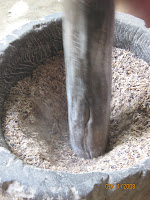Ka pan-okan ni ava
Sikdupen ko’d anufan
Isirak ni kovidan
Inaspul ko’s kapitan
Os
piyan yos, Os piyan yos
Sedag, sedag ka’n bulan
Mo silvi’y nak pan-akshan
Bato-bato’y katinan
Bolo-bolo’y pashenan
Inteneng nen Kabunyan
Os
piyan yos, Os piyan yos
Mahevas’sa mateba
Inenufan ko’d uma
Esemsem si kapitan
Imbetbet to’y kampilan
Avadak i etam-an
Os
piyan yos, Os piyan yos
Manbejokbok e shala
Bintik ko’y shenget nen ina
Inufop ko’d ejam-an
Palado’y nangis nen ina
In-avigan to’s kapitan
Os
piyan yos, Os piyan yos
In-ayag sha sun Kabunyan
Makavas sha imbungan
Sininop sha’y kaidian
Eshadsak sha impangan
Engkikan pay si kapitan
Os
piyan yos, os piyan yos
The song speaks of a hunter who asked his mother to wake up and cook ava (gabi) so he would have a sikdop (packed food) to eat with a meat of a kombilan (female deer) as he goes hunting. Along his way, he met a kapitan.
It was early dawn so he had to ask Kabunyan to make the moon light his stony and weedy path and Kabunyan heard his prayer.
He was able to catch a healthy deer and the same kapitan he met earlier got mad (esemsem) (I don’t know why) and hit him with his kampilan.
The hunter was hit in his shoulder. He then ran for the shenget (headdress) of his mother and used it to stop the bleeding. His mother cried hard and cursed (in-avigan) the kapitan.
The people were then gathered and offered a makavas (deer?) to Kabunyan. The people ate well, so did the kapitan.
The Igorots referred to a Spaniard as kapitan. The use of the kampilan by the kapitan in the song proves that the kapitan was not a fellow Ibaloi. A kampilan is a saber/sword used by 19th century Spanish soldiers (Ibaloy book, 2011). If the kapitan was a fellow Ibaloy or a busol (enemy from other Igorot tribes), he would have used an Ibaloi’s sholos or etak (bolo) or other hunting weapon by other Igorots.
Apart from Dr. Pungayan's article, this is how I understood the song. In this day, the case would have been attempted or frustrated murder(?) and so back then, the leaders of the community had to settle the case. They needed to butcher an animal for the settling of the case that was why the kapitan was also there and ate with the community. The people were invited to witness the hearing of the case. The fact that the kapitan ate with the people and with the victim meant that the case was settled and all was well. That was how the Ibaloys settled cases in the past and to this day in some Ibaloy communities. This song might have also been written in the latter part of the Spaniards’ stay in the Philippines where some Spaniards were able to get through some parts of Benguet and settle with the Ibaloys. Otherwise, had it happened in the earlier times when the Ibaloys were more aggressive and resistant to the Spaniards, the kapitan (and his men) would have gone to the lowlands without their heads. Yes, the early Ibaloys were also headtakers, but that's another story.






